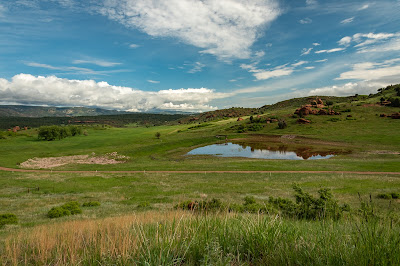On my Devil's Head Trail hike last week I got a tip to check out Sandstone Ranch Open Space in Larkspur. It's relatively new, having just opened to the public in September 2020. After a rainy weekend had me very ready to get back outside, I headed down on Monday to check it out.
The open space has two main trails. I decided to try the Sandstone Meadow Loop first, and was rewarded with this lovely vista at the "Wildlife Overlook." I assume wildlife may come to drink from the pond? Whatever the case, the scenery didn't really suffer from a lack of animals.
Following the unfortunate but not unexpected demise of my trusty Nikon D5200 after about 10 years of shooting in snow, sand, rain, fog, and temperatures ranging from 10 degrees below zero to 120 degrees above, I was down to just one camera body. That meant having to decide what lens I wanted to keep on -- my 18-105 landscape lens or my 80-400 zoom that I use for wildlife and wildflowers. I stuck with the landscape lens for a while, but it soon became apparent that the trail's most photogenic subjects right now are ...
... WILDFLOWERS! Crazy what a month will double the normal amount of rainfall will do for plant life, right? So I switched to the zoom lens and took advantage of the bright overcast conditions to get shots of many different blooming wildflowers. So the commentary going forward is basically going to be their names, courtesy of iNaturalist as usual. :)
First up: Western Spiderwort
First up: Western Spiderwort
Red-seeded Dandelion gone to seed
Erigeron longipes, no common name given
Yellow Salsify, a favorite of mine
And last but not least, Redstem Stork's-Bill. I'm sure I missed a few, but capturing 15 distinct species on one hike still seems pretty solid.
You know what else you get when conditions are wetter than normal? Fungi! These I know really nothing about whatsoever, but iNaturalist claims this one is Coprin de Romagnesi. I actually don't think the pictures look that similar. Hopefully another contributor will either confirm or correct.
And this may be Panaeolus antillarum, with some natural fertilizer conveniently placed alongside.
I never did switch back to my landscape lens. I also never got any wildlife shots, which surprised me a little. I did see a striking yellow-and-black bird that I couldn't get close enough to for a quality photo. I expected to at least see some butterflies and bees, but maybe it's not warm enough yet. Whatever the reasons for those absences, what I did see was truly splendid. It took me just under two hours to cover just under four miles, which is a pretty typical pace for me when I'm shooting. The day was still young, my legs were still fresh, and another trail beckoned!



















No comments:
Post a Comment